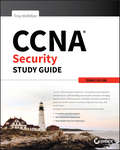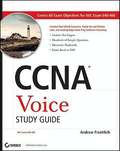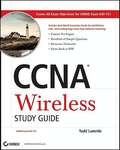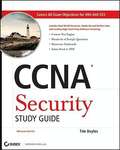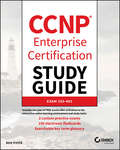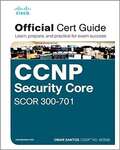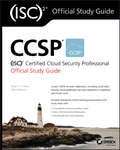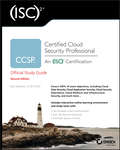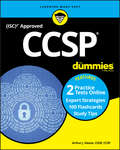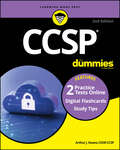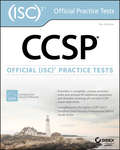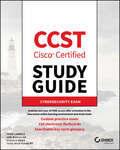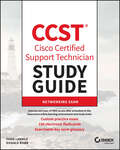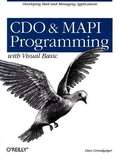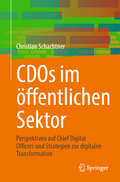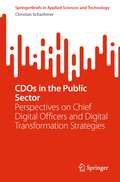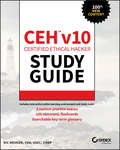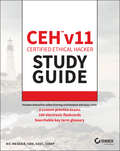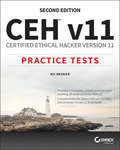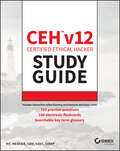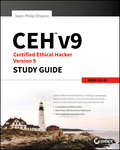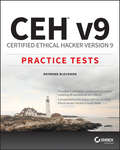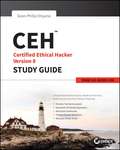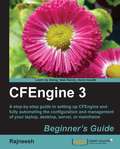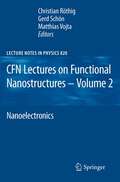- Table View
- List View
CCNA Security Study Guide: Exam 210-260
by Troy McMillanLay the foundation for a successful career in network security CCNA Security Study Guide offers comprehensive review for Exam 210-260. Packed with concise explanations of core security concepts, this book is designed to help you successfully prepare for the exam. Expert instruction guides you through critical concepts relating to secure network infrastructure, access management, VPN encryption, Firewalls, intrusion prevention and more, with complete coverage of the CCNA exam objectives. Practical examples allow you to apply your skills in real-world scenarios, helping you transition effectively from "learning" to "doing". You also get access to the Sybex online learning environment, featuring the tools you need to maximize your study time: key terminology and flash cards allow you to study anytime, anywhere, while chapter tests and practice exams help you track your progress and gauge your readiness along the way. The CCNA Security certification tests your knowledge of secure network installation, monitoring, and troubleshooting using Cisco security hardware and software solutions. When you're ready to get serious about preparing for the exam, this book gives you the advantage of complete coverage, real-world application, and extensive learning aids to help you pass with confidence. Master Cisco security essentials, standards, and core technologies Work through practical examples drawn from real-world examples Track your progress with online study aids and self-tests Develop critical competencies in maintaining data integrity, confidentiality, and availability Earning your CCNA Security certification validates your abilities in areas that define careers including network security, administrator, and network security support engineer. With data threats continuing to mount, the demand for this skill set will only continue to grow—and in an employer's eyes, a CCNA certification makes you a true professional. CCNA Security Study Guide is the ideal preparation resource for candidates looking to not only pass the exam, but also succeed in the field.
CCNA Voice Study Guide
by Andrew FroehlichThe ultimate guide to the new CCNA voice network administrator certification examThe new CCNA Voice exam tests candidates on their ability to implement a Cisco VoIP solution. Network administrators of voice systems will appreciate that the CCNA Voice Study Guide focuses completely on the information required by the exam.Along with hands-on labs and an objective map showing where each objective is covered, this guide includes a CD with the Sybex Test Engine, flashcards, and entire book in PDF format.The new CCNA Voice certification will be valuable for administrators of voice network systems using Cisco VoIP solutionsFrom Sybex, the leading CCNA publisher, this guide offers in-depth coverage of every exam objective and the technology developed by Cisco for VoIP systemsCovers the components of the Cisco Unified Communications Architecture as well as PSTN and VoIP components and technologiesShows how to configure gateways, voice ports, and dial peersDemonstrates how to configure a Cisco network to support VoIP and implement voicemailCD-ROM includes the Sybex Test Engine, flashcards, and entire book in PDF formatCCNA Voice Study Guide will thoroughly prepare candidates for the new CCNA Voice certification.Note: CD-ROM/DVD and other supplementary materials are not included as part of eBook file.
CCNA Wireless Study Guide
by Todd LammleA complete guide to the CCNA Wireless exam by leading networking authority Todd Lammle The CCNA Wireless certification is the most respected entry-level certification in this rapidly growing field. Todd Lammle is the undisputed authority on networking, and this book focuses exclusively on the skills covered in this Cisco certification exam. The CCNA Wireless Study Guide joins the popular Sybex study guide family and helps network administrators advance their careers with a highly desirable certification. The CCNA Wireless certification is the most respected entry-level wireless certification for system administrators looking to advance their careers Written by Todd Lammle, the leading networking guru and author of numerous bestselling certification guides Provides in-depth coverage of every exam objective and the technology developed by Cisco for wireless networking Covers WLAN fundamentals, installing a basic Cisco wireless LAN and wireless clients, and implementing WLAN security Explains the operation of basic WCS, basic WLAN maintenance, and troubleshooting Companion CD includes the Sybex Test Engine, flashcards, and entire book in PDF format Includes hands-on labs, end-of-chapter review questions, Exam Essentials overview, Real World Scenarios, and a tear-out objective map showing where each exam objective is covered The CCNA Wireless Study Guide prepares any network administrator for exam success. Note: CD-ROM/DVD and other supplementary materials are not included as part of eBook file.
CCNA® Security Study Guide
by Tim BoylesA complete study guide for the new CCNA Security certification exam In keeping with its status as the leading publisher of CCNA study guides, Sybex introduces the complete guide to the new CCNA security exam. The CCNA Security certification is the first step towards Cisco's new Cisco Certified Security Professional (CCSP) and Cisco Certified Internetworking Engineer-Security. CCNA Security Study Guide fully covers every exam objective. The companion CD includes the Sybex Test Engine, flashcards, and a PDF of the book. The CCNA Security certification is the first step toward Cisco's new CCSP and Cisco Certified Internetworking Engineer-Security Describes security threats facing modern network infrastructures and how to mitigate threats to Cisco routers and networks using ACLs Explores implementing AAA on Cisco routers and secure network management and reporting Shows how to implement Cisco IOS firewall and IPS feature sets plus site-to-site VPNs using SDM CD includes the Sybex Test Engine, flashcards, and the book in PDF format With hands-on labs and end-of-chapter reviews, CCNA Security Study Guide thoroughly prepares you for certification. Note: CD-ROM/DVD and other supplementary materials are not included as part of eBook file.
CCNP Enterprise Certification Study Guide: Exam 350-401
by Ben PiperThe practical and conceptual knowledge you need to attain CCNP Enterprise certification From one of the most trusted study guide publishers comes CCNP Enterprise Certification Study Guide: Exam 350-401. This guide helps you develop practical knowledge and best practices for critical aspects of enterprise infrastructure so you can gain your CCNP Enterprise certification. If you’re hoping to attain a broader range of skills and a solid understanding of Cisco technology, this guide will also provide fundamental concepts for learning how to implement and operate Cisco enterprise network core technologies. By focusing on real-world skills, each chapter prepares you with the knowledge you need to excel in your current role and beyond. It covers emerging and industry-specific topics, such as SD-WAN, network design, wireless, and automation. This practical guide also includes lessons on: ● Automation ● Network assurance ● Security ● Enterprise infrastructure ● Dual-stack architecture ● Virtualization In addition to helping you gain enterprise knowledge, this study guidecan lead you toward your Cisco specialist certification. When you purchase this guide, you get access to the information you need to prepare yourself for advances in technology and new applications, as well as online study tools such as: ● Bonus practice exams ● Pre-made flashcards ● Glossary of key terms ● Specific focus areas Expand your skillset and take your career to the next level with CCNP Enterprise Certification Study Guide.
CCNP and CCIE Security Core SCOR 350-701 Official Cert Guide
by Omar SantosCCNP and CCIE Security Core SCOR 350-701 Official Cert Guide presents you with an organized test preparation routine using proven series elements and techniques. “Do I Know This Already?” quizzes open each chapter and allow you to decide how much time you need to spend on each section. Exam topic lists make referencing easy. Chapter-ending Exam Preparation Tasks help you drill on key concepts you must know thoroughly. <p><p> CCNP and CCIE Security Core SCOR 350-701 Official Cert Guide, from Cisco Press allows you to succeed on the exam the first time and is the only self-study resource approved by Cisco. Best-selling author and leading security engineer Omar Santos shares preparation hints and test-taking tips, helping you identify areas of weakness and improve both your conceptual knowledge and hands-on skills.
CCSP (ISC)2 Certified Cloud Security Professional Official Study Guide
by Ben Malisow O'HaraThe only official study guide for the new CCSP exam CCSP (ISC)2 Certified Cloud Security Professional Official Study Guide is your ultimate resource for the CCSP exam. As the only official study guide reviewed and endorsed by (ISC)2, this guide helps you prepare faster and smarter with the Sybex study tools that include pre-test assessments that show you what you know, and areas you need further review. Objective maps, exercises, and chapter review questions help you gauge your progress along the way, and the Sybex interactive online learning environment includes access to a PDF glossary, hundreds of flashcards, and two complete practice exams. Covering all CCSP domains, this book walks you through Architectural Concepts and Design Requirements, Cloud Data Security, Cloud Platform and Infrastructure Security, Cloud Application Security, Operations, and Legal and Compliance with real-world scenarios to help you apply you skills along the way. The CCSP is the latest credential from the (ISC)2 and the Cloud Alliance, designed to show employers that you have what it takes to keep their organization safe in the cloud. Learn the skills you need to be confident on exam day and beyond. Review 100% of all CCSP exam objectives Practice applying essential concepts and skills Access the industry-leading online study tool set Test your knowledge with bonus practice exams and more As organizations become increasingly reliant on cloud-based IT, the threat to data security looms larger. Employers are seeking qualified professionals with a proven cloud security skillset, and the CCSP credential brings your resume to the top of the pile. CCSP (ISC)2 Certified Cloud Security Professional Official Study Guide gives you the tools and information you need to earn that certification, and apply your skills in a real-world setting.
CCSP (ISC)2 Certified Cloud Security Professional Official Study Guide
by Ben MalisowThe only official study guide for the new CCSP exam CCSP (ISC)2 Certified Cloud Security Professional Official Study Guide is your ultimate resource for the CCSP exam. As the only official study guide reviewed and endorsed by (ISC)2, this guide helps you prepare faster and smarter with the Sybex study tools that include pre-test assessments that show you what you know, and areas you need further review. Objective maps, exercises, and chapter review questions help you gauge your progress along the way, and the Sybex interactive online learning environment includes access to a PDF glossary, hundreds of flashcards, and two complete practice exams. Covering all CCSP domains, this book walks you through Architectural Concepts and Design Requirements, Cloud Data Security, Cloud Platform and Infrastructure Security, Cloud Application Security, Operations, and Legal and Compliance with real-world scenarios to help you apply your skills along the way. The CCSP is the latest credential from (ISC)2 and the Cloud Security Alliance, designed to show employers that you have what it takes to keep their organization safe in the cloud. Learn the skills you need to be confident on exam day and beyond. Review 100% of all CCSP exam objectives Practice applying essential concepts and skills Access the industry-leading online study tool set Test your knowledge with bonus practice exams and more As organizations become increasingly reliant on cloud-based IT, the threat to data security looms larger. Employers are seeking qualified professionals with a proven cloud security skillset, and the CCSP credential brings your resume to the top of the pile. CCSP (ISC)2 Certified Cloud Security Professional Official Study Guide gives you the tools and information you need to earn that certification, and apply your skills in a real-world setting.
CCSP For Dummies with Online Practice
by DeaneSecure your CSSP certification CCSP is the world’s leading Cloud Security certification. It covers the advanced technical skills and knowledge to design, manage, and secure data, applications, and infrastructure in the cloud using best practices, policies, and procedures. If you’re a cloud security professional seeking your CSSP certification, this book is a perfect way to prepare for the exam. Covering in detail all six domains, the expert advice in this book gives you key information you'll need to pass the exam. In addition to the information covered on the exam, you'll get tips on setting up a study plan, tips for exam day, and access to an online test bank of questions. Key information for all six exam domains Test -taking and exam day tips and tricks Free online practice questions and flashcards Coverage of the core concepts From getting familiar with the core concepts to establishing a study plan, this book is all you need to hang your hat on that certification!
CCSP For Dummies: Book + 2 Practice Tests + 100 Flashcards Online
by Arthur J. DeaneGet CCSP certified and elevate your career into the world of cloud security CCSP For Dummies is a valuable resource for anyone seeking to gain their Certified Cloud Security Professional (CCSP) certification and advance their cloud security career. This book offers a thorough review of subject knowledge in all six domains, with real-world examples and scenarios, so you can be sure that you’re heading into test day with the most current understanding of cloud security. You’ll also get tips on setting up a study plan and getting ready for exam day, along with digital flashcards and access to two updated online practice tests. . Review all content covered on the CCSP exam with clear explanations Prepare for test day with expert test-taking strategies, practice tests, and digital flashcards Get the certification you need to launch a lucrative career in cloud security Set up a study plan so you can comfortably work your way through all subject matter before test dayThis Dummies study guide is excellent for anyone taking the CCSP exam for the first time, as well as those who need to brush up on their skills to renew their credentials.
CCSP Official (ISC)2 Practice Tests
by Ben MalisowThe only official CCSP practice test product endorsed by (ISC)² With over 1,000 practice questions, this book gives you the opportunity to test your level of understanding and gauge your readiness for the Certified Cloud Security Professional (CCSP) exam long before the big day. These questions cover 100% of the CCSP exam domains, and include answers with full explanations to help you understand the reasoning and approach for each. Logical organization by domain allows you to practice only the areas you need to bring you up to par, without wasting precious time on topics you’ve already mastered. As the only official practice test product for the CCSP exam endorsed by (ISC)², this essential resource is your best bet for gaining a thorough understanding of the topic. It also illustrates the relative importance of each domain, helping you plan your remaining study time so you can go into the exam fully confident in your knowledge. When you’re ready, two practice exams allow you to simulate the exam day experience and apply your own test-taking strategies with domains given in proportion to the real thing. The online learning environment and practice exams are the perfect way to prepare, and make your progress easy to track.
CCST Cisco Certified Support Technician Study Guide: Cybersecurity Exam (Sybex Study Guide)
by Todd Lammle Todd Montgomery Jon Buhagiar Donald RobbThe ideal prep guide for earning your CCST Cybersecurity certification CCST Cisco Certified Support Technician Study Guide: Cybersecurity Exam is the perfect way to study for your certification as you prepare to start or upskill your IT career. Written by industry expert and Cisco guru Todd Lammle, this Sybex Study Guide uses the trusted Sybex approach, providing 100% coverage of CCST Cybersecurity exam objectives. You’ll find detailed information and examples for must-know Cisco cybersecurity topics, as well as practical insights drawn from real-world scenarios. This study guide provides authoritative coverage of key exam topics, including essential security principles, basic network security concepts, endpoint security concepts, vulnerability assessment and risk management, and incident handling. You also get one year of FREE access to a robust set of online learning tools, including a test bank with hundreds of questions, a practice exam, a set of flashcards, and a glossary of important terminology. The CCST Cybersecurity certification is an entry point into the Cisco certification program, and a pathway to the higher-level CyberOps. It’s a great place to start as you build a rewarding IT career! Study 100% of the topics covered on the Cisco CCST Cybersecurity certification exam Get access to flashcards, practice questions, and more great resources online Master difficult concepts with real-world examples and clear explanations Learn about the career paths you can follow and what comes next after the CCSTThis Sybex study guide is perfect for anyone wanting to earn their CCST Cybersecurity certification, including entry-level cybersecurity technicians, IT students, interns, and IT professionals.
CCST Cisco Certified Support Technician Study Guide: Networking Exam
by Todd Lammle Donald RobbThe ideal prep guide for earning your CCST Networking certification CCST Cisco Certified Support Technician Study Guide: Networking Exam is the perfect way to study for your certification as you prepare to start or upskill your IT career. Written by industry expert and Cisco networking guru Todd Lammle, this Sybex Study Guide uses the trusted Sybex approach, providing 100% coverage of CCST Networking exam objectives. You’ll find detailed information and examples for must-know Cisco networking topics, as well as practical insights drawn from real-world scenarios. This Study Guide provides authoritative coverage of key exam topics, including standards and concepts, addressing and subnet formats, endpoints and media types, infrastructure, diagnosing problems, and security. You also get one year of FREE access to a robust set of online learning tools, including a test bank with hundreds of questions, a practice exam, a set of flashcards, and a glossary of important terminology. The CCST Networking certification is an entry point into the Cisco certification program, and a pathway to the higher-level CCNA, so it’s a great place to start as you build a rewarding career! Study 100% of the topics covered on the Cisco CCST Networking certification exam Get access to flashcards, practice questions, and more great resources online Master difficult concepts with real-world examples and clear explanations Learn about the career paths you can follow and what comes next after the CCSTThis Sybex study guide is perfect for anyone wanting to earn their CCST Networking certification, including entry-level network technicians, networking students, interns, and IT professionals.
CDO & MAPI Programming with Visual Basic
by Dave GrundgeigerComputers and devices are more connected now than ever before. Why? Because the humans who use those computers need to collaborate. We need to share information, and we need to do it quickly, without regard to the physical distance that separates us. Corporate solution developers now more than ever have the opportunity and responsibility to enable people to communicate in ways never before possible. CDO and MAPI Programming with Visual Basic: Developing Mail and Messaging Applications dives deep into Microsoft's Collaboration Data Objects (CDO) and the Messaging Application Programming Interface (MAPI), then moves into succinct explanations of the types of useful messaging applications that can be written in Visual Basic. Microsoft has given the Visual Basic community Collaboration Data Objects (CDO)--a technology that goes far beyond simple email, fully into the realm of information workflow. CDO enables Visual Basic applications to exchange not only classic email, but in fact any information in a straightforward and easy way. The Internet--sometimes seen as a barrier by developers--is turned into an open pipe, ready to take your application's data around the world. Routing documents and building email list servers is just the beginning. Harness the power of worldwide communication in your everyday business applications. MAPI is the cornerstone of messaging on the Windows platforms, and profoundly influences the way you will write your collaboration applications. Understanding this technology lays the foundation for adding effective collaboration capabilities to your own applications. CDO and MAPI Programming with Visual Basic: Developing Mail and Messaging Applications fills a gap in an exciting and relatively young, yet popular, technology that lacks adequate documentation.
CDOs im öffentlichen Sektor: Perspektiven auf Chief Digital Officers und Strategien zur digitalen Transformation
by Christian SchachtnerDieses Buch untersucht die Notwendigkeit innovativer Ansätze zur Administrationsdigitalisierung, indem Technologien wie KI, Blockchain und intelligente Prozesse genutzt werden, um den Erwartungen der Bürger gerecht zu werden. Besonderes Augenmerk liegt auf der Rolle der Chief Digital Officers (CDOs) bei der erfolgreichen digitalen Transformation innerhalb öffentlicher Institutionen. Die digitale Verwaltung erfordert frische Impulse, um mit den Fortschritten im Industriesektor Schritt zu halten, indem Technologien wie KI-gesteuerte Automatisierung, Blockchain-Transaktionen und Sicherheitswerkzeuge eingesetzt werden. Intelligente Prozesslösungen werden als transformativ angesehen, um die Service-Standards gemäß den Erwartungen der Bürger an den Staat aufrechtzuerhalten. Im Gegensatz zu kommerziellen Unternehmen bietet die Zusammenarbeit denjenigen, die die Digitalisierung im öffentlichen Sektor überwachen, erweiterte Skalierungsmöglichkeiten, indem sie auf Erfahrungen aus anderen Regionen und Metropolen zurückgreifen, die direkt anwendbar und wiederverwendbar sind. Im öffentlichen Bereich spiegeln digitale Strategien rechtliche und soziale Bedingungen wider, was Anpassungen und Anpassungsoptionen für Chief Digital Officers erforderlich macht, während sie die digitale Transformation leiten. Methodische Schwerpunkte in der Neugestaltung von Aufgabenstrukturen, Prozessoptimierung und der Motivation von Akteuren ergeben vielfältige Handlungsfelder für die neue Rolle des CDO in öffentlichen Institutionen. Dieses Buch untersucht die Instrumente, Strategien und Einstellungen, die notwendig sind, um transformative Initiativen in Organisationen erfolgreich umzusetzen, und betont bewährte Konzepte mit praktischer Anwendbarkeit, die es den Lesern ermöglichen, ihre eigenen Interaktionsmöglichkeiten als digitale Führungspersönlichkeiten abzuleiten. Das Buch ist eine prägnante Einführung in die spezifischen Anforderungen an visionäre Gestalter, die dynamische Veränderungen in nutzerzentrierten öffentlichen Dienstleistungen vorantreiben.
CDOs in the Public Sector: Perspectives on Chief Digital Officers and Digital Transformation Strategies (SpringerBriefs in Applied Sciences and Technology)
by Christian SchachtnerThis book explores the need for innovative approaches to administrative digitization, leveraging technologies such as AI, blockchain, and smart processes to meet citizens' expectations, with a particular focus on the role of Chief Digital Officers (CDOs) in driving successful digital transformations within public institutions. Administrative digitization requires fresh inputs to match the leaps seen in the industry sector, utilizing technologies like AI-driven automation, blockchain transactions, and security tools. Smart process solutions are seen as transformative in upholding service standards aligned with citizens' state expectations. Unlike commercial companies, collaboration offers those overseeing public sector digitization enhanced scaling opportunities by drawing from experiences in other regions and metropolises, directly applicable and reusable. In the public realm, digital strategies mirror legal and social conditions, necessitating adjustments and adaptation options for Chief Digital Officers as they lead digital transformation. Methodological focal points in task structure redesign, process optimization, and motivating actors yield diverse action areas for the CDO's new role in public institutions. This book explores the instruments, strategies, and attitudes necessary to successfully implement transformative initiatives in organizations, emphasizing proven concepts with practical applicability, enabling readers to derive their own interaction options as digital guidance leaders. The book is a concise introduction to the specific requirements for visionary designers driving dynamic changes in user-centric public services.
CEH v10 Certified Ethical Hacker Study Guide
by Ric MessierAs protecting information becomes a rapidly growing concern for today’s businesses, certifications in IT security have become highly desirable, even as the number of certifications has grown. Now you can set yourself apart with the Certified Ethical Hacker (CEH v10) certification. The CEH v10 Certified Ethical Hacker Study Guide offers a comprehensive overview of the CEH certification requirements using concise and easy-to-follow instruction. Chapters are organized by exam objective, with a handy section that maps each objective to its corresponding chapter, so you can keep track of your progress. The text provides thorough coverage of all topics, along with challenging chapter review questions and Exam Essentials, a key feature that identifies critical study areas. Subjects include intrusion detection, DDoS attacks, buffer overflows, virus creation, and more. This study guide goes beyond test prep, providing practical hands-on exercises to reinforce vital skills and real-world scenarios that put what you’ve learned into the context of actual job roles. Gain a unique certification that allows you to understand the mind of a hacker Expand your career opportunities with an IT certificate that satisfies the Department of Defense’s 8570 Directive for Information Assurance positions Fully updated for the 2018 CEH v10 exam, including the latest developments in IT security Access the Sybex online learning center, with chapter review questions, full-length practice exams, hundreds of electronic flashcards, and a glossary of key terms Thanks to its clear organization, all-inclusive coverage, and practical instruction, the CEH v10 Certified Ethical Hacker Study Guide is an excellent resource for anyone who needs to understand the hacking process or anyone who wants to demonstrate their skills as a Certified Ethical Hacker.
CEH v11 Certified Ethical Hacker Study Guide
by Ric MessierAs protecting information continues to be a growing concern for today’s businesses, certifications in IT security have become highly desirable, even as the number of certifications has grown. Now you can set yourself apart with the Certified Ethical Hacker (CEH v11) certification. The CEH v11 Certified Ethical Hacker Study Guide offers a comprehensive overview of the CEH certification requirements using concise and easy-to-follow instructions. Chapters are organized by exam objective, with a handy section that maps each objective to its corresponding chapter, so you can keep track of your progress. The text provides thorough coverage of all topics, along with challenging chapter review questions and Exam Essentials, a key feature that identifies critical study areas. Subjects include common attack practices like reconnaissance and scanning. Also covered are topics like intrusion detection, DoS attacks, buffer overflows, wireless attacks, mobile attacks, Internet of Things (IoT) and more. This study guide goes beyond test prep, providing practical hands-on exercises to reinforce vital skills and real-world scenarios that put what you’ve learned into the context of actual job roles. Gain a unique certification that allows you to function like an attacker, allowing you to identify vulnerabilities so they can be remediated Expand your career opportunities with an IT certificate that satisfies the Department of Defense’s 8570 Directive for Information Assurance positions Fully updated for the 2020 CEH v11 exam, including the latest developments in IT security Access the Sybex online learning center, with chapter review questions, full-length practice exams, hundreds of electronic flashcards, and a glossary of key terms Thanks to its clear organization, all-inclusive coverage, and practical instruction, the CEH v11 Certified Ethical Hacker Study Guide is an excellent resource for anyone who needs to understand the hacking process or anyone who wants to demonstrate their skills as a Certified Ethical Hacker.
CEH v11: Certified Ethical Hacker Version 11 Practice Tests
by Ric MessierMaster CEH v11 and identify your weak spots CEH: Certified Ethical Hacker Version 11 Practice Tests are the ideal preparation for this high-stakes exam. Five complete, unique practice tests are designed to help you identify weak spots in your understanding, so you can direct your preparation efforts efficiently and gain the confidence—and skills—you need to pass. These tests cover all section sections of the exam blueprint, allowing you to test your knowledge of Background, Analysis/Assessment, Security, Tools/Systems/Programs, Procedures/Methodology, Regulation/Policy, and Ethics. Coverage aligns with CEH version 11, including material to test your knowledge of reconnaissance and scanning, cloud, tablet, and mobile and wireless security and attacks, the latest vulnerabilities, and the new emphasis on Internet of Things (IoT). The exams are designed to familiarize CEH candidates with the test format, allowing them to become more comfortable apply their knowledge and skills in a high-pressure test setting. The ideal companion for the Sybex CEH v11 Study Guide, this book is an invaluable tool for anyone aspiring to this highly-regarded certification. Offered by the International Council of Electronic Commerce Consultants, the Certified Ethical Hacker certification is unique in the penetration testing sphere, and requires preparation specific to the CEH exam more than general IT security knowledge. This book of practice tests help you steer your study where it needs to go by giving you a glimpse of exam day while there's still time to prepare. Practice all seven sections of the CEH v11 exam Test your knowledge of security, tools, procedures, and regulations Gauge your understanding of vulnerabilities and threats Master the material well in advance of exam day By getting inside the mind of an attacker, you gain a one-of-a-kind perspective that dramatically boosts your marketability and advancement potential. If you're ready to attempt this unique certification, the CEH: Certified Ethical Hacker Version 11 Practice Tests are the major preparation tool you should not be without.
CEH v12 Certified Ethical Hacker Study Guide with 750 Practice Test Questions (Sybex Study Guide)
by Ric MessierThe latest version of the official study guide for the in-demand CEH certification, now with 750 Practice Test Questions Information security and personal privacy remains a growing concern for businesses in every sector. And even as the number of certifications increases, the Certified Ethical Hacker, Version 12 (CEH v12) maintains its place as one of the most sought-after and in-demand credentials in the industry. In CEH v12 Certified Ethical Hacker Study Guide with 750 Practice Test Questions, you’ll find a comprehensive overview of the CEH certification requirements. Concise and easy-to-follow instructions are combined with intuitive organization that allows you to learn each exam objective in your own time and at your own pace. The Study Guide now contains more end of chapter review questions and more online practice tests. This combines the value from the previous two-book set including a practice test book into a more valuable Study Guide. The book offers thorough and robust coverage of every relevant topic, as well as challenging chapter review questions, even more end of chapter review questions to validate your knowledge, and Exam Essentials, a key feature that identifies important areas for study. There are also twice as many online practice tests included. You’ll learn about common attack practices, like reconnaissance and scanning, intrusion detection, DoS attacks, buffer overflows, wireless attacks, mobile attacks, Internet of Things vulnerabilities, and more. It also provides: Practical, hands-on exercises that reinforce vital, real-world job skills and exam competencies Essential guidance for a certification that meets the requirements of the Department of Defense 8570 Directive for Information Assurance positions Complimentary access to the Sybex online learning center, complete with chapter review questions, full-length practice exams, hundreds of electronic flashcards, and a glossary of key terms The CEH v12 Certified Ethical Hacker Study Guide with 750 Practice Test Questions is your go-to official resource to prep for the challenging CEH v12 exam and a new career in information security and privacy.
CEH v9: Certified Ethical Hacker Version 9
by OriyanoThe ultimate preparation guide for the unique CEH exam. The CEH v9: Certified Ethical Hacker Version 9 Study Guide is your ideal companion for CEH v9 exam preparation. This comprehensive, in-depth review of CEH certification requirements is designed to help you internalize critical information using concise, to-the-point explanations and an easy-to-follow approach to the material. Covering all sections of the exam, the discussion highlights essential topics like intrusion detection, DDoS attacks, buffer overflows, and malware creation in detail, and puts the concepts into the context of real-world scenarios. Each chapter is mapped to the corresponding exam objective for easy reference, and the Exam Essentials feature helps you identify areas in need of further study. You also get access to online study tools including chapter review questions, full-length practice exams, hundreds of electronic flashcards, and a glossary of key terms to help you ensure full mastery of the exam material. The Certified Ethical Hacker is one-of-a-kind in the cybersecurity sphere, allowing you to delve into the mind of a hacker for a unique perspective into penetration testing. This guide is your ideal exam preparation resource, with specific coverage of all CEH objectives and plenty of practice material. Review all CEH v9 topics systematically Reinforce critical skills with hands-on exercises Learn how concepts apply in real-world scenarios Identify key proficiencies prior to the exam The CEH certification puts you in professional demand, and satisfies the Department of Defense's 8570 Directive for all Information Assurance government positions. Not only is it a highly-regarded credential, but it's also an expensive exam--making the stakes even higher on exam day. The CEH v9: Certified Ethical Hacker Version 9 Study Guide gives you the intense preparation you need to pass with flying colors.
CEH v9: Certified Ethical Hacker Version 9 Practice Tests
by Raymond BlockmonMaster CEH v9 and identify your weak spots CEH: Certified Ethical Hacker Version 9 Practice Tests are the ideal preparation for this high-stakes exam. Five complete, unique practice tests are designed to help you identify weak spots in your understanding, so you can direct your preparation efforts efficiently and gain the confidence--and skills--you need to pass. These tests cover all five sections of the exam, allowing you to test your knowledge of Assessment; Security; Tools and Systems; Procedures and Methodology; and Regulation, Policy, and Ethics. Coverage aligns with CEH version 9, including material on cloud, tablet, and mobile phone security and attacks, as well as the latest vulnerabilities including Heartbleed, shellshock, and Poodle. The exams are designed to familiarize CEH candidates with the test format, allowing them to become more comfortable reading a Wireshark .pcap file or viewing visual depictions of network attacks. The ideal companion for the Sybex CEH v9 Study Guide, this book is an invaluable tool for anyone aspiring to this highly-regarded certification. Offered by the International Council of Electronic Commerce Consultants, the Certified Ethical Hacker certification is unique in the penetration testing sphere, and requires preparation specific to the CEH exam more than general IT security knowledge. This book of practice tests help you steer your study where it needs to go by giving you a glimpse of exam day while there's still time to prepare. Practice all five sections of the CEH v9 exam Test your knowledge of security, tools, procedures, and regulations Gauge your understanding of new vulnerabilities and threats Master the material well in advance of exam day By getting inside the mind of a hacker, you gain a one-of-a-kind perspective that dramatically boosts your marketability and advancement potential. If you're ready to attempt this unique certification, the CEH: Certified Ethical Hacker Version 9 Practice Tests are the major preparation tool you should not be without.
CEH: Certified Ethical Hacker Version 8 Study Guide
by Sean-Philip OriyanoPrepare for the new Certified Ethical Hacker version 8 examwith this Sybex guideSecurity professionals remain in high demand. The CertifiedEthical Hacker is a one-of-a-kind certification designed to givethe candidate a look inside the mind of a hacker. This study guideprovides a concise, easy-to-follow approach that covers all of theexam objectives and includes numerous examples and hands-onexercises. Coverage includes cryptography, footprinting andreconnaissance, scanning networks, enumeration of services, gainingaccess to a system, Trojans, viruses, worms, covert channels, andmuch more. A companion website includes additional study tools,Including practice exam and chapter review questions and electronicflashcards.Security remains the fastest growing segment of IT, and CEHcertification provides unique skillsThe CEH also satisfies the Department of Defense's 8570Directive, which requires all Information Assurance governmentpositions to hold one of the approved certificationsThis Sybex study guide is perfect for candidates studying ontheir own as well as those who are taking the CEHv8 courseCovers all the exam objectives with an easy-to-followapproachCompanion website includes practice exam questions, flashcards,and a searchable Glossary of key termsCEHv8: Certified Ethical Hacker Version 8 Study Guide isthe book you need when you're ready to tackle this challengingexamAlso available as a set, Etical Hacking and Web Hacking Set,9781119072171 with The Web Application Hacker's Handbook:Finding and Exploiting Security Flaws, 2nd Edition.
CFEngine 3 Beginner’s Guide
by RajneeshPart of Packt's Beginner's Guide series, this book guides you through setting up Cfengine to maximizing its potential. This book focuses on getting you through all the major learning points in a smooth, logical order. You'll also learn how to avoid some common pitfalls. If you are a System Administrator or Configuration manager with a growing infrastructure and if you are looking for a dependable tool to manage your infrastructure, then this book is for you. If your infrastructure is already big with hundreds and thousands of nodes and you are looking for a secure, versatile and stable configuration management tool, you will still find this book handy. You don't need any prior experience of Cfengine to follow this book.
CFN Lectures on Functional Nanostructures - Volume 2: Nanoelectronics (Lecture Notes in Physics #820)
by Christian Röthig Matthias Vojta Gerd SchönThis series of books contains selected and edited lectures from summer schools organized by the Center for Functional nanostructures (CFN) at the University of Karlsruhe. The mission of the CFN is to carry out research in the following areas: nanophotonics, nanoelectronics, molecular nanostructures and nanostructured materials. The aim of the summer schools is mainly to exchange new ideas and illustrate emerging research methodologies through a series of topical, introductory lectures. This is reflected by both the selection of topics addressed in the present volume, nanoelectronics, as well as the tutorial aspect of the contributions.
